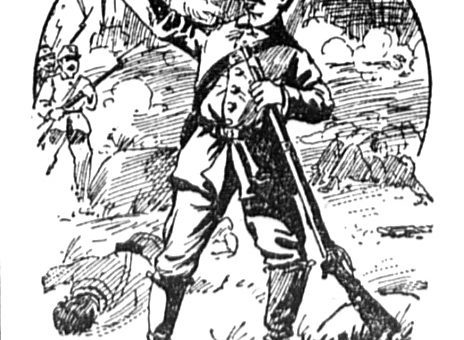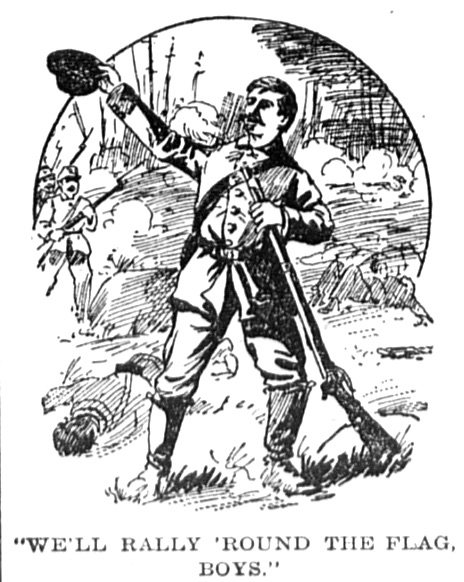
The Battle Cry of Freedom was a popular Union song during the Civil War. I’ve included a YouTube video for the song.
It was written by George F. Root in 1861. Below is the history of the song.
Famous Union Songs
Some That Awoke Patriotism and Renewed Courage in the Hearts of Weary Soldiers
When President Lincoln issued his second call for troops in the summer of 1861, the emergency had come when the union army needed a battle cry of freedom, and George F. Root, living in Chicago, was deeply impressed with the mighty significance of the proclamation, and one afternoon he caught the spirit of the hour and there began to evolve in his mind the sentiment of a rallying song, says the Philadelphia Press.
In an outburst of patriotic fervor there came the words and music of that soul stirring and pulse quickening battle hymn:
Yes, we’ll rally ‘round the flag, boys,
We’ll rally once again,
Shouting the battle cry of freedom.
We will rally from the hillside,
We will rally from the plain,
Shouting the battle cry of freedom.
CHORUS
The Union forever! Hurrah, boys, hurrah!
Down with the traitors, up with the stars,
While we rally ‘round the flag, boys,
Rally once again,
Shouting the battle cry of freedom.
The next evening the famous Lumbard brothers – Jules and Frank – the great singers of the war, were to sing at a meeting to be held in the Chicago courthouse square. Mr. Root gave them the “Battle Cry of Freedom.” The voices of the brothers were electrifying, and in trumpet like tones the refrain:
“The Union forever! Hurrah, boys, hurrah!”
spread as if impelled by some magnetic influence, and almost instantly the grand chorus rose in mighty music from the vast multitude.

The song struck fire and leaped into widespread popularity and usefulness.
Only a few days after it was written a monstrous war meeting was held in Union Square, New York. Excitement ran high, and the emotion was intense. The Hutchinson family sang the “Battle Cry of Freedom,” and the immense throng of listeners were aroused to the highest pitch of exaltation of soul.
The song was sung again and again, and the great audience caught up the refrain, and it proved a resistless force in swelling the ranks of the army.
No other war song was sung with bolder patriotism or with a more triumphant passion of the soul. It seemed to mount up as if on wings of magic, and was carried over all the north and into all ccamps where the Stars and Stripes floated. It was often ordered to be sung as the men marched into action, and more than once its strains rose on the battlefield to stimulate courage.
There is a stirring illustration of how this saved a battle.
During the terrible battle of the Wilderness on the 6th of May, 1864, a brigade of the Ninth Army Corps, having broken the enemy’s line by an assault, and with heavy loss were driven back in disorder.
They retreated but a few hundred yards, however, when they reformed and again confronted the enemy. Just then some gallant fellow – an unknown hero – in the Forty-fifth Pennsylvania, with a head filled with sense and a heart full of courage and song, began to sing:
“We’ll rally ‘round the flag, boys,
Rally once again,
Shouting the battle cry of freedom.”
The refrain was caught up by the entire regiment, and also by the regiments next in line. The air was filled with the crackle and smoke of the burning underbrush; the pitiful cries of the wounded, the rattle of musketry, and the wild shouts of command, gave intense excitement to the scene; but above all, answering the exalted yell of the enemy, rose supreme the inspiring chorus:
“The Union forever! Hurrah, boys, hurrah!”
Among many incidents connected with Dr. Root’s war songs, the one which touched him most deeply is related in his delightful “Story of a Musical Life.”
An Iowa regiment went in one of the charges during the siege of Vicksburg 800 strong, and came out with a terrible loss of more than half their number. But the remnant of the regiment left the battlefield waving their torn and powder stained flag, singing:
“Yes, we’ll rally ‘round the flag, boys.”
On the afternoon of July 4, 1896, a vast multitude of 10,000 assembled at the Coliseum in Chicago, the occasion being a war song festival for the benefit of the George F. Root monument fund.
It was a great day for the “Battle Cry of Freedom.” Chicago’s greatest singers took the solos and 1,000 children sang in the choruses. Mr. Jules Lumbards, the white-haired veteran, who was first to sing that famous battle hymn, 35 years before, sang it at the Coliseum, and every soul was thrilled by its newborn power.
Luther Laflin Mills, that superb orator, delivered the oration and among other things said:
“The songs of George F. Root abide and will remain in the memories and voices of our people, not only as reminders of the nation’s heroic struggle for self-preservation, but as a constant, inspiring and educating force in maintaining and strengthening the lofty sentiment of American patriotism.”
Source: Perrysburg journal. (Perrysburg, Wood Co., Ohio), 03 April 1903.

